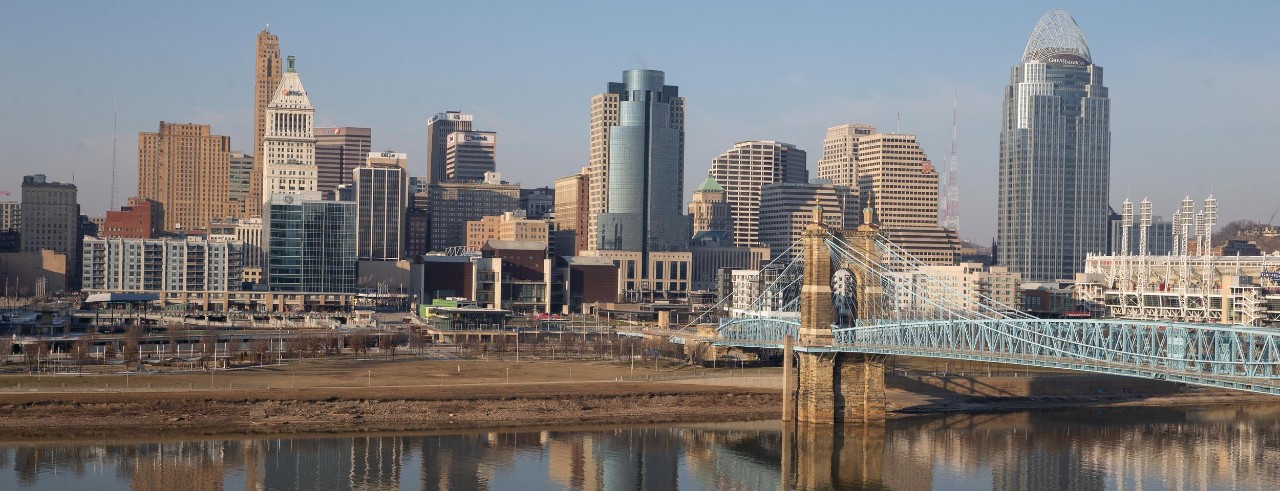
AP: What we know about the Ohio train derailment
UC environmental engineer explains how officials monitor pollution plume on Ohio River
The Associated Press turned to a University of Cincinnati environmental engineer to explain the risks to drinking water from pollution caused by a train derailment in eastern Ohio.
On Feb. 3, 38 cars derailed on a Norfolk Southern train carrying vinyl chloride and other cancer-causing chemicals. The resulting fire cast a huge black smoke plume high above East Palestine, Ohio, a village of nearly 5,000 people. Evacuations were ordered in both Ohio and Pennsylvania. Officials intentionally released some of the chemicals to mitigate the risk of explosion.
The chemicals killed 3,500 fish in creeks in East Palestine that lead to the Ohio River, Ohio's Department of Natural Resources said.
Now state and federal health officials are closely monitoring one of the detected chemicals, butyl acrylate, as it travels downstream toward Huntington, West Virginia. Butyl acrylate is used in resins and paints.

Patrick Ray
Patrick Ray, an assistant professor of environmental engineering in UC's College of Engineering and Applied Science, said the chemical is diluting and dissipating in the river. While any pollution is cause for concern, Ray said, the chemical detected in the river is below concentrations the Environmental Protection Agency considers a public health risk.
The AP fact-checked a map circulating on social media outlining an area across 11 states supposedly affected by the chemical spill. The AP found that the map actually depicts the vast region that drains into the Ohio River, nearly all of which is unaffected by the spill.
The more acute environmental and health risks are in the vicinity of the spill in East Palestine, where people rely on groundwater, Ray said.
“This map is showing an extremely large region that includes many, many counties that have nothing to do with the Ohio River at all,” Ray told the AP.
USA Today turned to Ray to help fact-check social media posts about the spill and its risks to the region.
Ray told WLWT-News 5 reporter Danielle Dindak that the chemical plume is a couple days upstream of Huntington, West Virginia, and more than a week away from Cincinnati. The concentrations have declined significantly since the disaster, Ray said.
“It's a big concern here,” Ray said pointing to East Palestine. “But the level of concern has been decreasing as it goes down the river.”
Ray also spoke with Local 12 reporter Cassy Arsenault about the risks to drinking water for other communities along the Ohio River, including Cincinnati. The pollution plume is traveling downstream about 1 mile per hour at concentrations of 4 parts per billion. The EPA says the chemical is a health concern at 500 parts per billion, Local 12 reported.
“The magic word is concentration,” Ray told Local 12. “That's how we measure the risk to human health.”
Ray said if contaminants in the Ohio River were to threaten Cincinnati's drinking water, the city can draw from reservoirs of clean water that can provide at least two days' worth of uninterrupted service to customers. Water treatment plants also have tools to filter contaminants from water.
Meanwhile, the Columbus Dispatch turned to UC College of Arts and Sciences professor David Stradling about the risks to groundwater posed by the spill for residents in East Palestine and the vicinity. Stradling is director of environmental studies at UC.
“We've put a lot of effort and money into making certain this infrastructure works. Now, people who are not on municipal supplies, they have their own wells, etc. and they're nearby, that's something different altogether,” Stradling told the Dispatch.
“It's not extraordinarily deep. There would be pretty good interchange between surface water and aquifer,” he said.
Featured image at top: The Cincinnati skyline is reflected in the Ohio River. Photo/Andrew Higley/UC Marketing + Brand
Related Stories
News Record: UC Engineers Without Borders makes impact
January 22, 2021
The University of Cincinnati student chapter of Engineers Without Borders makes a life-changing impact at home and abroad by helping to build schoolhouses and bring clean water to people who need it.
Enquirer: Power to Cincinnati water plant failed
October 6, 2022
UC engineering professors explain significance of Cincinnati water plant shutdown in May.
WCPO: UC students work on COVID-19 surveillance to prevent surge
January 31, 2024
WCPO highlighted the Ohio Department of Health's COVID-19 surveillance program that UC engineering students oversee. UC Associate Professor David Wendell recruits students to help monitor wastewater to track the virus on campus.
